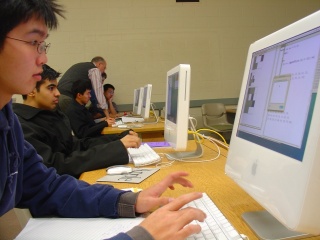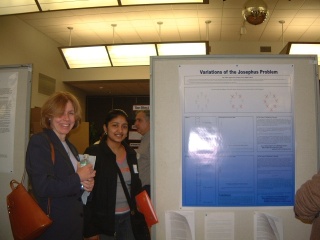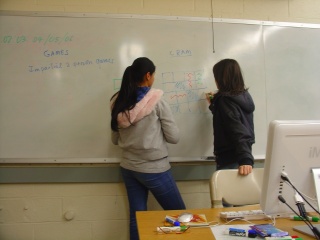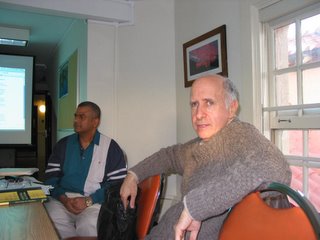Students Learn to Write Like Professional Mathematicians
Professor Robert Cowen teaches his students to write like professional mathematicians in Mathematics 213W, a course devoted to teaching students to tackle mathematical problems with Mathematica, a software program designed to enable complex computation. Whenever students write a paper for his class, Professor Cowen encourages them to model writing on articles published in professional mathematics journals. He has even created an extensive writing manual for the course, which explains the methods and conventions of professional writing in mathematics.
Professor Cowen consults as students use Mathematica to run computations.
Of course, professional mathematicians write when they
can offer new insight on mathematical problems. The same is true of Professor
Cowen's students. They are required to identify a genuine mathematical problem
-- in this case, the mathematical basis of ordinary games, like Cram or NIM-and
use Mathematica to seek a solution. Like professionals, students identify
mathematical problems, explain why they deserve investigation as well as the
attention of an informed reader, and write with a specialized audience in
mind. "Writing for mathematics was very different from what I regularly
do in school," says Neha Aggarwal, one of Professor Cowen's students.
She observes that much of what she learned involved habits of writing that
would apply in many contexts at the same time she learned writing practices
specific to mathematics: "I learned various ways of organizing my
writing and grabbing the attention of the reader. I also learned the importance
of pictures and graphs to portray my work better."
Math 213W student Neha Aggarwal with featured guest Judith Swan at WAC's recent conference, Scientific Writing at Queens College.
Recognizing that the feedback of colleagues is intrinsic to most professional writing, Professor Cowen teaches his students to read and review each other's writing the way the referees of professional journals do. Students receive very clear reviewing guidelines. This semester, Professor Cowen modeled the process for peer review by showing his students an article he was asked to review for a journal and soliciting their feedback on it. Once they learn how professional peer review works, the students review each other's drafts. Then, they meet in class to discuss each other's comments, questions inspired by the written reviews, and new possibilities for revision. They receive grades based on the helpfulness of their reviews, and they must submit cover letters with their revised essays. Cowen plays the role of journal editor, and in the end the students submit their revisions to him with a cover letter, explaining how and why they have implemented-or rejected-the suggestions of their reviewers, as they would to a professional editor.
Students at work on a mathematical problem.
Professor Cowen understands that writing is a process that involves revision, but he wasn't always sure how to teach students to revise. In his words,
"Peer editing" was a totally unfamiliar term to me two years ago. I was made aware of its meaning and usefulness through the writing seminars I took with the Queens College Writing Across the Curriculum program. This semester I decided to try it with my Math 213W students and I was frankly surprised how effective it was. My students read each other's papers with a seriousness of purpose and provided effective help which greatly improved the final drafts I received. In addition everyone learned to value good writing.
Professor Cowen at a session of Writing Across the Curriculum's Research Seminar on Writing and Learning.
These days, Professor Cowen engages his students in discussions of what makes good writing -- and the ways that good writing and solid mathematical thinking reinforce each other. His course emphasizes writing as process, collaboration, and communication.




